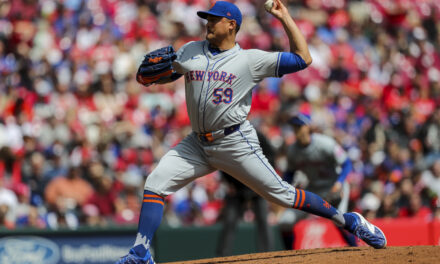
Stat Line: 4 IP, 7 R, 10 H, 10 K’s, 0 BB
Inconsistency in Fastball Command
Noah Syndergaard struggled to establish his two-seam fastball as many of the Padres hits came off of two-seamers that ran back over the middle of the plate. A two-seam fastball is relatively easy to learn but getting a feel for the amount of movement and having the ability to direct the movement of the baseball to the corners rather than from the corners is the one learning curve that Syndergaard will face.
Additionally, Syndergaard had trouble getting on top of the baseball at his release point which resulted in missing some of his two-seamers up. As a result, the two-seamers had a 9 to 3 movement (imagine 9 to 3 on clock) rather than the sharper 10 to 4 movement that creates groundballs and strikeouts.
Syndergaard didn’t completely lack fastball command as he struck out six of his 10 strikeouts via well located fastballs but in the end he made too many mistakes over the plate with his fastball.
Strikeout Pitches
It’s always strange and impressive when a pitcher gives up 10 hits and amasses 10 strikeouts in a game as we’ve now seen on back to back nights (see Andrew Cashner Monday night stat line). Unfortunately, Syndergaard needed 12 strikeouts.
The two run producing hits in the second inning came on 1-2 curveballs to left-handed hitters Alexi Amarista and Will Venable. Both of these curveballs were located right below knee high and over the middle of the plate. Especially against left-handed hitters that can see the baseball better and longer out of a right-handers hand, Syndergaard has to:
- Get these pitches to land in the dirt for a strikeout or ball result only.
- Pick one corner of the plate to throw the curveball towards so if he doesn’t get the ball in the dirt, the hitter will either take the pitch for a ball or will make poor contact.
If the batter takes the pitch for a ball and the count goes to 2-2, Syndergaard can either double up on a curveball in the dirt or throw a letter-high 97 mph fastball to induce a swing and miss strikeout. The worst case scenario is the count goes to 3-2, and Syndergaard can challenge them with a 97 mph two-seamer.
The broader issue is that Syndergaard is still learning how to bear down in key situations which will be imperative to his long term success.
Curveball Breaks Momentum
This was the first outing since Syndergaard’s debut against the Chicago Cubs that he found himself in real jams. Although he didn’t have success on Tuesday night getting out of trouble, Syndergaard did use a simple yet savvy pitch selection tactic as the momentum in the game turned against him.
Syndergaard began to start off many of the Padres hitters with first pitch curveballs for called strikes. This is extremely effective because in these situations the hitters are typically looking to drive in runs or “mash” the baseball. This approach by hitters leads them to look “dead red” or only look for a fastball early in the count which usually results in the hitter taking any off-speed pitch early in the count. This creates an opportunity for the pitcher to get ahead of the hitter to gain control of an at-bat and slow down the momentum of the inning.
Overall, Syndergaard showed strong curveball command (excluding the two curveballs described above) throwing 17 of his 22 curveballs for strikes (77.3% strike rate).
Stat of the night
Syndergaard didn’t allow any walks. This speaks to the combination of Syndergaard making mistakes over the plate and the Padres hitters taking advantage of those pitches. Additionally, it shows Syndergaard didn’t shy away from the Padres contact and continually attacked hitters which are great intangibles from a young MLB pitcher.















